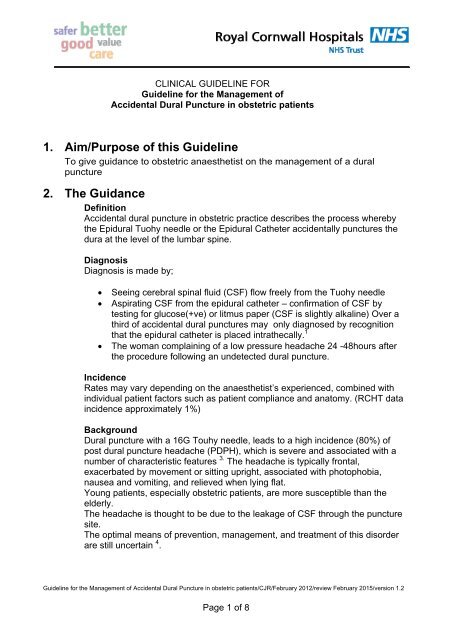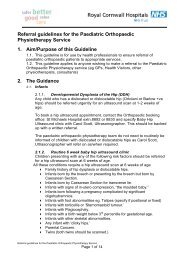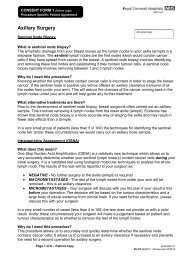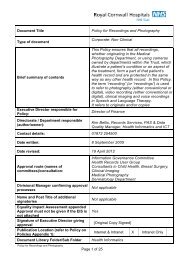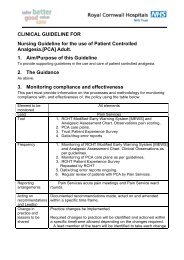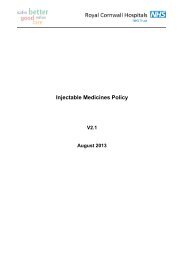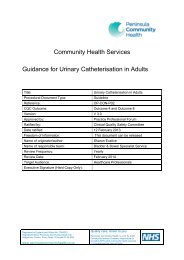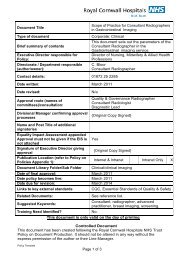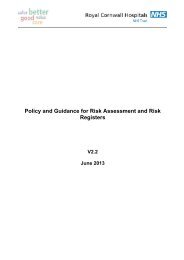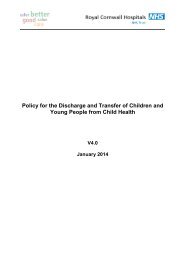Guideline for the management of accidental dural puncture
Guideline for the management of accidental dural puncture
Guideline for the management of accidental dural puncture
You also want an ePaper? Increase the reach of your titles
YUMPU automatically turns print PDFs into web optimized ePapers that Google loves.
CLINICAL GUIDELINE FOR<strong>Guideline</strong> <strong>for</strong> <strong>the</strong> Management <strong>of</strong>Accidental Dural Puncture in obstetric patients1. Aim/Purpose <strong>of</strong> this <strong>Guideline</strong>To give guidance to obstetric anaes<strong>the</strong>tist on <strong>the</strong> <strong>management</strong> <strong>of</strong> a <strong>dural</strong><strong>puncture</strong>2. The GuidanceDefinitionAccidental <strong>dural</strong> <strong>puncture</strong> in obstetric practice describes <strong>the</strong> process whereby<strong>the</strong> Epi<strong>dural</strong> Tuohy needle or <strong>the</strong> Epi<strong>dural</strong> Ca<strong>the</strong>ter <strong>accidental</strong>ly <strong>puncture</strong>s <strong>the</strong>dura at <strong>the</strong> level <strong>of</strong> <strong>the</strong> lumbar spine.DiagnosisDiagnosis is made by;Seeing cerebral spinal fluid (CSF) flow freely from <strong>the</strong> Tuohy needleAspirating CSF from <strong>the</strong> epi<strong>dural</strong> ca<strong>the</strong>ter – confirmation <strong>of</strong> CSF bytesting <strong>for</strong> glucose(+ve) or litmus paper (CSF is slightly alkaline) Over athird <strong>of</strong> <strong>accidental</strong> <strong>dural</strong> <strong>puncture</strong>s may only diagnosed by recognitionthat <strong>the</strong> epi<strong>dural</strong> ca<strong>the</strong>ter is placed intra<strong>the</strong>cally. 1The woman complaining <strong>of</strong> a low pressure headache 24 -48hours after<strong>the</strong> procedure following an undetected <strong>dural</strong> <strong>puncture</strong>.IncidenceRates may vary depending on <strong>the</strong> anaes<strong>the</strong>tist’s experienced, combined withindividual patient factors such as patient compliance and anatomy. (RCHT dataincidence approximately 1%)BackgroundDural <strong>puncture</strong> with a 16G Touhy needle, leads to a high incidence (80%) <strong>of</strong>post <strong>dural</strong> <strong>puncture</strong> headache (PDPH), which is severe and associated with anumber <strong>of</strong> characteristic features 3. The headache is typically frontal,exacerbated by movement or sitting upright, associated with photophobia,nausea and vomiting, and relieved when lying flat.Young patients, especially obstetric patients, are more susceptible than <strong>the</strong>elderly.The headache is thought to be due to <strong>the</strong> leakage <strong>of</strong> CSF through <strong>the</strong> <strong>puncture</strong>site.The optimal means <strong>of</strong> prevention, <strong>management</strong>, and treatment <strong>of</strong> this disorderare still uncertain 4 .<strong>Guideline</strong> <strong>for</strong> <strong>the</strong> Management <strong>of</strong> Accidental Dural Puncture in obstetric patients/CJR/February 2012/review February 2015/version 1.2Page 1 <strong>of</strong> 8
Immediate ActionIf you experience a needle tap, try to thread <strong>the</strong> epi<strong>dural</strong> ca<strong>the</strong>ter so that 3cmis in <strong>the</strong> subarachnoid space 5 .If you elicit pain or paraes<strong>the</strong>sia do not advance <strong>the</strong> ca<strong>the</strong>ter fur<strong>the</strong>r.If ca<strong>the</strong>ter tap, leave ca<strong>the</strong>ter in CSF.Clearly LABEL <strong>the</strong> intra<strong>the</strong>cal ca<strong>the</strong>ter and tell <strong>the</strong> patient and midwife that<strong>the</strong> anaes<strong>the</strong>tist must do all top ups.Give 1ml 0.25% Bupivicaine with 25mcg Fentanyl <strong>for</strong> labour analgesia. Thiscan be flushed with 2ml 0.9% sodium chloride.Expect to repeat intra<strong>the</strong>cal doses every 1-2 hours with doses ranging from0.5-1.5mls plain 0.25% bupivicaine.Alternatively, you can re-site <strong>the</strong> epi<strong>dural</strong> ca<strong>the</strong>ter at a different space andremove <strong>the</strong> old one. If a fur<strong>the</strong>r tap occurs a consultant anaes<strong>the</strong>tist must becalled.If you do re-site <strong>the</strong> epi<strong>dural</strong> ca<strong>the</strong>ter, <strong>the</strong> bolus regimen given by <strong>the</strong>midwifery team should only be considered if several bolus top-ups by <strong>the</strong>Anaes<strong>the</strong>tist have not exhibited excessively fast onset or unusually extensiveblock (because <strong>of</strong> <strong>the</strong> previous <strong>dural</strong> <strong>puncture</strong>/tear).Explain what has happened to <strong>the</strong> mo<strong>the</strong>r and that pain relief can beprovided.Make sure that <strong>the</strong> midwifery/obstetric and senior anaes<strong>the</strong>tic staffunderstand <strong>the</strong> nature <strong>of</strong> <strong>the</strong> block and your <strong>management</strong> plan.Document <strong>management</strong> plan in <strong>the</strong> notes.Remember: High blocks may occur with intra<strong>the</strong>cal ca<strong>the</strong>ters, or resitedepi<strong>dural</strong>s in patients who have had inadvertent <strong>dural</strong> <strong>puncture</strong> 5DeliveryThe presence <strong>of</strong> a <strong>dural</strong> <strong>puncture</strong> does not require a change <strong>of</strong> plan <strong>for</strong>delivery.For a vaginal delivery use <strong>the</strong> above intra<strong>the</strong>cal dosing regime.If caesarean section required titrate 0.5ml increments <strong>of</strong> 0.5% plainBupivicaine to <strong>the</strong> required level <strong>of</strong> block.One dose <strong>of</strong> Morphine 0.1mg can be given additionally <strong>for</strong> post-operativeanalgesia.After <strong>the</strong> delivery, <strong>the</strong> ca<strong>the</strong>ter should be removed as normal.Do not per<strong>for</strong>m a prophylactic blood patch.Post DeliveryThere is no good evidence that en<strong>for</strong>ced recumbency, is <strong>of</strong> any use in <strong>the</strong>prevention <strong>of</strong> post <strong>dural</strong> <strong>puncture</strong> headache (PDPH).Encourage good hydration ( IV fluids and oral)Review <strong>the</strong> woman daily until dischargedDo not en<strong>for</strong>ce a prolonged inpatient stay, but if discharged allow mo<strong>the</strong>r anopen appointment to return to post natal ward.<strong>Guideline</strong> <strong>for</strong> <strong>the</strong> Management <strong>of</strong> Accidental Dural Puncture in obstetric patients/CJR/February 2012/review February 2015/version 1.2Page 2 <strong>of</strong> 8
Discuss <strong>the</strong> <strong>dural</strong> <strong>puncture</strong> again with <strong>the</strong> mo<strong>the</strong>r and discuss <strong>the</strong> signs <strong>of</strong>PDPH and <strong>the</strong> possibility that some headaches will resolve spontaneouslywithin 6 weeks 6 . Ensure regular analgesia is prescribed: Paracetamol + Codeine +Dicl<strong>of</strong>enac. Also a laxative should be prescribed to avoid straining: Fybogel. Consider Sumatriptan and Caffeine <strong>the</strong>rapy 7, 8 . If PDPH symptoms are severe and not abating with simple treatments asabove, <strong>the</strong>n a blood patch should be considered and discussed with <strong>the</strong>patient. Plans should be made <strong>for</strong> a blood patch, ideally with a consultantobstetric anaes<strong>the</strong>tist <strong>the</strong> next morning. Two anaes<strong>the</strong>tists must be presentduring <strong>the</strong> procedure. The success <strong>of</strong> an epi<strong>dural</strong> blood patch depends on using as much as 20 ml<strong>of</strong> blood, injected no higher than <strong>the</strong> <strong>dural</strong> <strong>puncture</strong> about 48 hours after <strong>the</strong><strong>dural</strong> <strong>puncture</strong>. The patient should be kept horizontal (slight head up allowed) <strong>for</strong> 2 hoursafter patching, and advised to avoid bending or straining afterwards 9 . If a mo<strong>the</strong>r has a blood patch, she should be <strong>of</strong>fered follow up by one <strong>of</strong> <strong>the</strong>Consultant Obstetric Anaes<strong>the</strong>tists.Important pointsPost<strong>dural</strong> <strong>puncture</strong> headache must be distinguished from tension headache,migraine, pre-eclampsia, meningitis, cortical vein thrombosis, intracerebralhaemorrhage, sub<strong>dural</strong> haematoma and intracranial tumour. A history <strong>of</strong><strong>dural</strong> <strong>puncture</strong> may be absent. An MRI may assist in <strong>the</strong> differentialdiagnosis.The headache varies in character but is relieved by lying down and byabdominal compression. Associated symptoms include neck ache, nausea,vomiting, photophobia and diplopia.A neglected <strong>dural</strong> leak may result in convulsions or cranial sub<strong>dural</strong>haematoma, coning and death.If <strong>the</strong> epi<strong>dural</strong> ca<strong>the</strong>ter is not retained intra<strong>the</strong>cally, it can be resited at ahigher interspace. This may risk a second <strong>dural</strong> <strong>puncture</strong> and can cause ahigh block 10 .All women require careful documentation, close monitoring, and top-upsadministered by an anaes<strong>the</strong>tist.Bed rest is <strong>of</strong> no prophylactic value but, in <strong>the</strong> presence <strong>of</strong> headache,mobilisation should be postponed pending definitive treatment. Hydrationand analgesia provide only symptomatic relief. Epi<strong>dural</strong> saline providestransient relief and some discom<strong>for</strong>t. Epi<strong>dural</strong> blood patch relieves symptomsand stops <strong>the</strong> CSF leak and is <strong>the</strong>re<strong>for</strong>e definitive treatment. Some womenwill experience a mild backache following <strong>the</strong> procedure.Alternatives to blood, such as dextran 40, may be useful <strong>for</strong> women whodecline blood products or if <strong>the</strong>re is bacteraemia.<strong>Guideline</strong> <strong>for</strong> <strong>the</strong> Management <strong>of</strong> Accidental Dural Puncture in obstetric patients/CJR/February 2012/review February 2015/version 1.2Page 3 <strong>of</strong> 8
Leaving <strong>the</strong> intra<strong>the</strong>cal ca<strong>the</strong>ter insitu <strong>for</strong> 24-hours post delivery may reduce<strong>the</strong> incidence <strong>of</strong> PDPH from 80 to 60% 5 , however all epi<strong>dural</strong> ca<strong>the</strong>ters mustbe removed be<strong>for</strong>e women are transferred to <strong>the</strong> post-natal ward.References1. Van de Velde M, Schepers R, et al. Ten years <strong>of</strong> experience with <strong>accidental</strong> <strong>dural</strong> <strong>puncture</strong> and post<strong>dural</strong> <strong>puncture</strong> headache in a tertiary obstetric anaes<strong>the</strong>tic department. International Journal <strong>of</strong>Anaes<strong>the</strong>sia.2009; 17:329-335.2. Gleeson CM, Reynolds E. Accidental <strong>dural</strong> <strong>puncture</strong> rates in UK obstetric practice. International Journal<strong>of</strong> Obstetric Anaes<strong>the</strong>sia. 1998 Oct;7(4):242-63. Stride PC, Cooper GM: Dural taps revisited. A 20-year survey from Birmingham Maternity Hospital.Anaes<strong>the</strong>sia 1993; 48:247-55.4. Harrington BE, Schmitt AM. Meningeal <strong>puncture</strong> headache, unintentional <strong>dural</strong> <strong>puncture</strong>, and <strong>the</strong>epi<strong>dural</strong> blood patch: a national survey <strong>of</strong> United States practice. Reg Anaesth Pain Med, 2009Sep-Oct;34(5):430-7.5. Rutter SV, Shields F et al. Management <strong>of</strong> <strong>accidental</strong> <strong>dural</strong> <strong>puncture</strong> in labour with intra<strong>the</strong>cal ca<strong>the</strong>ters:an analysis <strong>of</strong> 10 years experience. International Journal <strong>of</strong> Obstetric Anaes<strong>the</strong>sia.2001; 10:177-181.6. Turnbull DK, Shepherd DB. Post <strong>dural</strong> <strong>puncture</strong> headache pathogenesis, prevention and treatment.British Journal <strong>of</strong> Anaes<strong>the</strong>sia 2003; 91: 718–29.7. Camann WR, Murray RS etal. Effects <strong>of</strong> oral caffeine on post<strong>dural</strong> <strong>puncture</strong> headache. A double-blind,placebo-controlled trial. Anaes<strong>the</strong>sia & Analgesia. 1990; 70:181-4.8. Carp H, Singh PJ et al. Effects <strong>of</strong> <strong>the</strong> serotonin receptor agonist sumatriptan on post<strong>dural</strong> <strong>puncture</strong>headache; report <strong>of</strong> six cases. Anaes<strong>the</strong>sia & Analgesia 1994;79:180-2M Rupasinghe. Recognition and treatment <strong>of</strong> post-<strong>dural</strong> <strong>puncture</strong> headache.Anaes<strong>the</strong>sia&intensive care medicine3. Compliance monitoring and effectivenessElement to bemonitoredAll women with a post <strong>dural</strong> <strong>puncture</strong> will be followed up by<strong>the</strong> Obstetric Anaes<strong>the</strong>tist on-call and feedback given to <strong>the</strong>Anaes<strong>the</strong>tist who per<strong>for</strong>med <strong>the</strong> procedures.LeadToolFrequencyReportingarrangementsActing onrecommendationsand Lead(s)Change inpractice andlessons to besharedObstetric anaesthtic lead consultantReview <strong>of</strong> notes <strong>of</strong> all woman with a post <strong>dural</strong> <strong>puncture</strong>Every woman with a post <strong>dural</strong> <strong>puncture</strong>Through <strong>the</strong> maternity risk <strong>management</strong> <strong>for</strong>umMaternity risk <strong>management</strong> <strong>for</strong>um will monitor any action plansarisingOne to one feedback to individual anaes<strong>the</strong>tistsAny training needs will be addressed by <strong>the</strong> training lead <strong>for</strong>anaes<strong>the</strong>tics4. Equality and Diversity4.1. This document complies with <strong>the</strong> Royal Cornwall Hospitals NHS Trust serviceEquality and Diversity statement.<strong>Guideline</strong> <strong>for</strong> <strong>the</strong> Management <strong>of</strong> Accidental Dural Puncture in obstetric patients/CJR/February 2012/review February 2015/version 1.2Page 4 <strong>of</strong> 8
Links to key external standardsRelated Documents:Training Need Identified?Epi<strong>dural</strong> analgesia in labourTraining as per training log bookVersion Control TableDateJanuary2006December2009February2012Version NoV1.0 Initial IssueSummary <strong>of</strong> ChangesV1.0 Added care post <strong>dural</strong> tap and follow up.V1.2Added compliance monitoring DocumentManager Upload Form.Changes Made by(Name and Job Title)DR Bill HarveyConsultantanaes<strong>the</strong>tistDr Ca<strong>the</strong>rine RalphConsultantanaes<strong>the</strong>tistDr Ca<strong>the</strong>rine RalphConsultantanaes<strong>the</strong>tist[Please complete all boxes and delete help notes in blue italics including this note]All or part <strong>of</strong> this document can be released under <strong>the</strong> Freedom <strong>of</strong> In<strong>for</strong>mationAct 2000This document is to be retained <strong>for</strong> 10 years from <strong>the</strong> date <strong>of</strong> expiry.This document is only valid on <strong>the</strong> day <strong>of</strong> printingControlled DocumentThis document has been created following <strong>the</strong> Royal Cornwall Hospitals NHS TrustPolicy on Document Production. It should not be altered in any way without <strong>the</strong>express permission <strong>of</strong> <strong>the</strong> author or <strong>the</strong>ir Line Manager.<strong>Guideline</strong> <strong>for</strong> <strong>the</strong> Management <strong>of</strong> Accidental Dural Puncture in obstetric patients/CJR/February 2012/review February 2015/version 1.2Page 6 <strong>of</strong> 8
Appendix 2.Initial Equality Impact Assessment Screening Formme <strong>of</strong> service, strategy, policy or project (hereafter referred to as policy) to be assessed:<strong>Guideline</strong> <strong>for</strong> <strong>the</strong> Management <strong>of</strong> Accidental Dural Puncture in obstetric patientsDirectorate and service area:Is this a new or existing Procedure?Obstetrics and gynaecologyExistingName <strong>of</strong> individual completingTelephone:assessment: Jan Clarkson01872 2522701. Policy Aim* To in<strong>for</strong>m obstetric anaes<strong>the</strong>tists in <strong>the</strong> correct <strong>management</strong><strong>of</strong> a <strong>dural</strong> tap2. Policy Objectives* To ensure appropriate <strong>management</strong> <strong>of</strong> a <strong>dural</strong> tap3. Policy – intendedOutcomes*5. How will youmeasure <strong>the</strong> outcome?5. Who is intended tobenefit from <strong>the</strong> Policy?Safety <strong>of</strong> <strong>the</strong> obstetric womanCompliance monitoring toolObstetric women6a. Is consultationrequired with <strong>the</strong>work<strong>for</strong>ce, equalitygroups, local interestgroups etc. around thispolicy?b. If yes, have <strong>the</strong>segroups been consulted?c. Please list any groupswho have been consultedabout this procedure.*Please see Glossary7. The ImpactPlease complete <strong>the</strong> following table using ticks. You should refer to <strong>the</strong> EA guidance notes<strong>for</strong> areas <strong>of</strong> possible impact and also <strong>the</strong> Glossary if needed. Where you think that <strong>the</strong> policy could have a positive impact on any <strong>of</strong> <strong>the</strong> equalitygroup(s) like promoting equality and equal opportunities or improving relationswithin equality groups, tick <strong>the</strong> ‘Positive impact’ box. Where you think that <strong>the</strong> policy could have a negative impact on any <strong>of</strong> <strong>the</strong> equalitygroup(s) i.e. it could disadvantage <strong>the</strong>m, tick <strong>the</strong> ‘Negative impact’ box.<strong>Guideline</strong> <strong>for</strong> <strong>the</strong> Management <strong>of</strong> Accidental Dural Puncture in obstetric patients/CJR/February 2012/review February 2015/version 1.2Page 7 <strong>of</strong> 8
Where you think that <strong>the</strong> policy has no impact on any <strong>of</strong> <strong>the</strong> equality group(s) listedbelow i.e. it has no effect currently on equality groups, tick <strong>the</strong> ‘No impact’ box.EqualityGroupAgePositiveImpactNegativeImpactNoImpactReasons <strong>for</strong> decisionDisabilityReligion orbeliefGenderTransgenderPregnancy/MaternityRaceYesSexualOrientationMarriage / CivilPartnershipYou will need to continue to a full Equality Impact Assessment if <strong>the</strong> following havebeen highlighted: A negative impact and No consultation (this excludes any policies which have been identified as notrequiring consultation).8. If <strong>the</strong>re is no evidence that <strong>the</strong> policypromotes equality, equal opportunitiesor improved relations - could it beadapted so that it does? How?Full statement <strong>of</strong> commitment to policy <strong>of</strong>equal opportunities is included in <strong>the</strong> policyPlease sign and date this <strong>for</strong>m.Keep one copy and send a copy to Matron, Equality, Diversity and Human Rights,c/o Royal Cornwall Hospitals NHS Trust, Human Resources Department, ChyveanHouse, Penventinnie Lane, Truro, Cornwall, TR1 3LJA summary <strong>of</strong> <strong>the</strong> results will be published on <strong>the</strong> Trust’s web site.Signed _Jan Clarkson_Date 10 th February 2012<strong>Guideline</strong> <strong>for</strong> <strong>the</strong> Management <strong>of</strong> Accidental Dural Puncture in obstetric patients/CJR/February 2012/review February 2015/version 1.2Page 8 <strong>of</strong> 8


